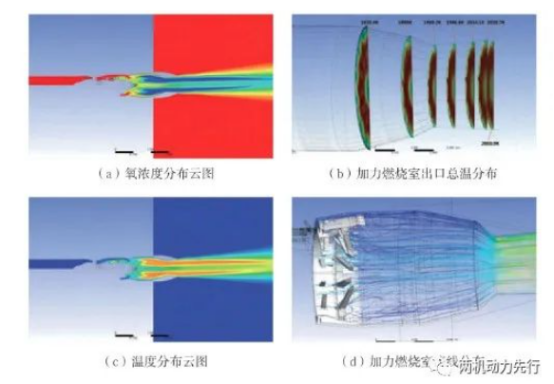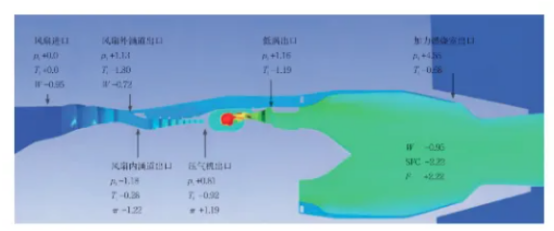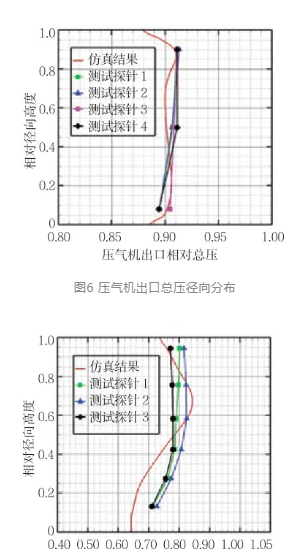High-precision aerodynamic and combustion coupled simulation
Due to the multiphase flow characteristics of fuel atomization, evaporation, mixing, and rapid chemical reactions inside the combustion chamber or afterburner, and the high-speed flow inside the compressor and turbine has high flow curvature, shock wave wake boundary layer interaction, and mixing of the sealing flow and the mainstream. Therefore, there are very obvious differences between the combustion chamber flow simulation and the internal flow of the impeller components, and it is necessary to conduct targeted research on the aerodynamic and combustion coupling simulation model to ensure high simulation accuracy. The focus needs to break through the high-precision simulation technology of complex reaction flows and high-speed internal flows of turbomachinery, and combine the current simulation results and test results to verify the model parameters and evaluate the accuracy. To this end, in view of the low accuracy of the combustion model in the full three-dimensional simulation of the whole machine in full afterburner state, the afterburner combustion model has been improved, the problem of excessively high afterburner outlet temperature has been overcome, and a new chemical reaction model with completely independent intellectual property rights has been formed, and the evaluation accuracy has been improved by more than 40%. Figure 4 shows the full three-dimensional simulation results of a type of engine in full afterburner state. By comparing with the test data, it is shown that the accuracy of the afterburner combustion chamber outlet temperature assessment has been greatly improved, and the performance parameters of the engine in the maximum state have been accurately obtained.

Simulation of coupling between engine main flow and air system secondary flow
In order to understand the internal flow characteristics of the engine main flow path, cavity flow path and disc cavity flow path under the mutual interference, accurately evaluate the engine axial force and detailed distribution of the air system flow path, and further improve the accuracy of the full three-dimensional simulation of the engine, it is necessary to carry out a full three-dimensional simulation study of the engine considering the influence of primary and secondary flows [4]. Considering the problems of complex full three-dimensional model of primary and secondary flows of the whole engine, large grid volume, and long calculation time, in order to reduce technical risks, a research method from simple to complex and from easy to difficult is adopted. First, the simulation technology of single components such as fans, compressors, and turbines considering the influence of primary and secondary flows is studied to obtain the flow law and simulation method of primary and secondary flow coupling of single components. Then, the grid models of each component are assembled and calculated and solved by assigning initial fields, and the full three-dimensional primary and secondary flow coupling simulation results of the engine are obtained. By comparing with the test results, the full three-dimensional simulation results of the whole engine considering the primary and secondary flow coupling are more accurate. At the same time, the axial force of the engine rotor and the flow distribution of the whole air system can also be accurately obtained. The axial force evaluation accuracy is as high as 5%, and the air flow distribution accuracy is 2%, which provides good data support for engine design and testing. Follow the official account: Two-Aircraft Power First, get massive two-aircraft design information for free, and focus on two-aircraft knowledge and key technologies!
Machine simulation accuracy verification
In order to verify the accuracy of the whole machine simulation and improve the engineering applicability of the whole machine simulation method, the test data collation and analysis work based on the engine system was carried out, the calibration and accuracy verification of the whole machine full three-dimensional simulation method was realized, and a set of high-precision whole machine performance prediction methods was developed. Figure 5 shows the comparison between the CFD simulation results and the test measurement results of a small bypass ratio engine, where pt is the total pressure, Tt is the total temperature, W is the flow rate,π is the component expansion ratio, F is the engine thrust, and SFC is the fuel consumption rate [5]. The test data verification shows that the whole machine performance prediction model has a high evaluation accuracy, the engine inlet flow deviation is within 1%, and the thrust deviation is about 2%. Figures 6 and 7 respectively show the radial distribution of the compressor and turbine outlet parameters and the test comparison curve. Through comparative analysis, it is found that the radial parameter distribution accuracy obtained by three-dimensional simulation is about 3%, which fully shows that the full three-dimensional simulation technology of the engine has reached a high level and can be directly applied to the design and test of aircraft engines.




Complete machine CFD digital simulation and management platform
In order to improve the efficiency of whole-machine simulation and realize parameter automation and standardized input and output, a whole-machine CFD digital simulation and management platform was built to realize centralized and unified management of the models, meshes, and boundary conditions of each component, ensuring that the acquired models and meshes can be automatically updated in real time with the real technical status of the engine. The built whole-machine full 3D simulation platform integrates the pre- and post-processing modules of whole-machine simulation automation, which can realize the rapid loading of boundary conditions of the calculation model and the rapid acquisition of whole-machine performance parameters, reducing the simulation time from the original 16 weeks to only 4 weeks, greatly improving the simulation efficiency.
Conclusion
The full three-dimensional simulation technology of aircraft engines has achieved rapid and high-precision prediction of the performance parameters of the whole machine. With the help of whole-machine simulation, the pace of engine development has been accelerated, the development cycle has been shortened, the test risk has been reduced, and “the design is in place once and the test is successful once” has been ensured. At present, this method has been successfully practiced in multiple engine projects, guiding engine design, testing and troubleshooting, and fully verifying the importance of innovative projects in accelerating the development of aviation engines. At the same time, the innovation team also summarized the project results, comprehensively sorted out the whole-machine simulation process, built a complete digital simulation platform, and summarized a series of design standards, guidelines and specifications, which provided strong support for enriching and improving the construction of the R&D system.
